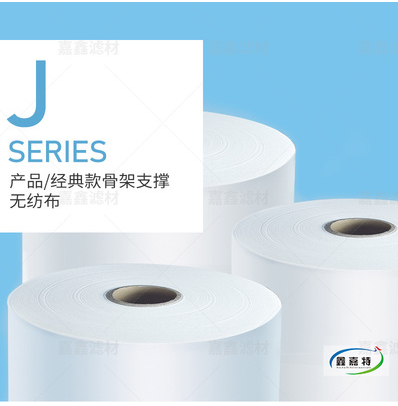The mixed non-woven fabric technology is a new technology that utilizes papermaking equipment and processes to produce non woven products or paper composite materials. In developed countries such as Japan and the United States, it has been widely used, forming the advantage of large-scale industrialization. This technology breaks through traditional textile principles and avoids complex processes such as cotton texture, spinning, and knitting, which have high labor temperature and low production efficiency. It makes reasonable use of papermaking wet mesh technology, making fibers have good application prospects in the production process. Forming one product at a time on a paper machine. Greatly reducing labor temperature and improving labor productivity. This technology does not involve repeated processing of fiber raw materials. Fiber products are made directly from short fibers, which can reduce energy consumption, save manpower and resources, and reduce manufacturing costs.

Compared with other manufacturing methods for fiber products, it has the following characteristics:
Firstly, it is conducive to the conversion of small-scale papermaking and the control of environmental pollution
The warm process non-woven fabric technology can fully utilize existing papermaking equipment and can be converted into the production of non-woven products without significant technological transformation. The entire process from feeding to storage does not produce biological dust and harmful gases, and does not discharge waste liquid. Making/environmental pollution and developing new products is a practical technology for small-scale papermaking.
Secondly, it is conducive to the protection of water resources.
The source of non-woven fabric requires less water. Water can only be used for long-distance transportation of large fibers, but it is not used in systems. No outward discharge, no damage or waste to water resources. The small-scale papermaking production process is simple, and there is no water recovery facility. Direct discharge of production water. The promotion and application of this technology can alleviate the excessive development of water resources in small paper making, which is beneficial for the protection of water resources.
Thirdly, the source of raw materials is extensive.
Due to its weaving technology characteristics, warm method non-woven fabrics have strong adaptability to raw materials. Reasonable design can be carried out according to the final use requirements of the product, and fiber raw materials can be widely used for washing. In addition to emotional fibers, Juzhao, Yilianran, Jilun, Tiye, and fiberglass can also be used as raw materials. These raw materials can be used alone or mixed in proportion, which has special effects on the product. There are many domestic raw material manufacturers with a wide range of sources.
Fourth, there are multiple types of products and a wide range of applications
Source method non-woven fabric is a new type of fiber product, which differs from woven and knitted fabrics due to its structural characteristics. They are basically composed of fiber networks (non yarn networks). As long as different fiber raw materials are selected, different processing methods and different finishing processes are used, various non-woven fabric products with various properties and applications can be produced. It has been widely applied in many fields.
1. Medical and health care: surgical gowns, hats, masks; Patients use bed sheets and pillowcases; Bandages, ointments, etc
2. Home decoration and clothing: clothing village, dustproof clothing, labor protection clothing, dustproof masks, artificial leather, shoe insole leather, vacuum filter bags, shopping bags, sofa bags, etc.
3. Industrial cloth: Sound insulation felt for speakers, battery separator paper, fiberglass reinforced base cloth, filter material, electrical insulation cloth, cable cloth, tape cloth, etc.
4. Civil engineering and construction: geotextile, sound insulation material, insulation material, waterproof material, felt base cloth.
5. Automotive industry: carburetor filter elements, air filter elements, insulation felt, shockproof felt, styling materials, indoor decoration composite materials.
6. Agronomy: Rooting cloth, seedling cloth, insect proof cloth, anti freezing cloth, soil insulation cloth
7. Packaging materials: Composite cement bags, particle bags, packaging materials, and other packaging substrates.
8. Others: map cloth, calendar cloth, canvas, bandages, etc.
Fifth, the market potential is enormous and the economic benefits are significant.
Mixed non-woven fabric has the advantages of fast mesh speed, short process flow, high labor productivity, and low cost. Its labor productivity is 10-20 times that of the dry method, and the production cost is only 6-70% of that of the dry method. Having soft and strong market competitiveness and good economic benefits. At present, the production of wet non-woven fabrics in developed countries accounts for over 30% of the total production of non-woven fabrics and is still growing. The production of wet non-woven fabrics in China is relatively low, accounting for less than 5% of the total production of non-woven fabrics according to preliminary statistics. Compared with developed countries, wet non-woven fabrics have great market potential.
Sixth, it is conducive to the regeneration of resources and the suppression of white pollution.
Additives can be added to waste products and packaging materials that are prone to white pollution. Improving its biodegradability and using functional materials to improve its recycling performance and reduce recycling costs. In order to promote resource recycling and utilization, white pollution is proposed. In summary, wet non-woven fabric technology is in an advantageous position in China and has good development prospects. The development and production of wet non-woven fabrics comply with national industrial policies and sustainable development plans., Helps to improve overall labor productivity and reduce production costs. Significant economic and social benefits in environmental pollution control and rational utilization of alcohol and farmland